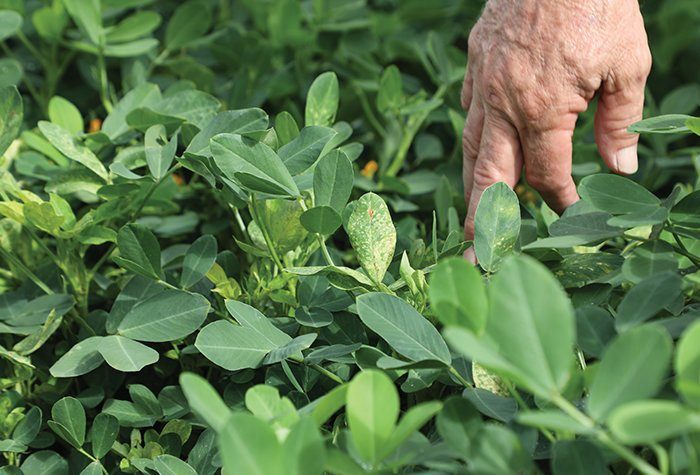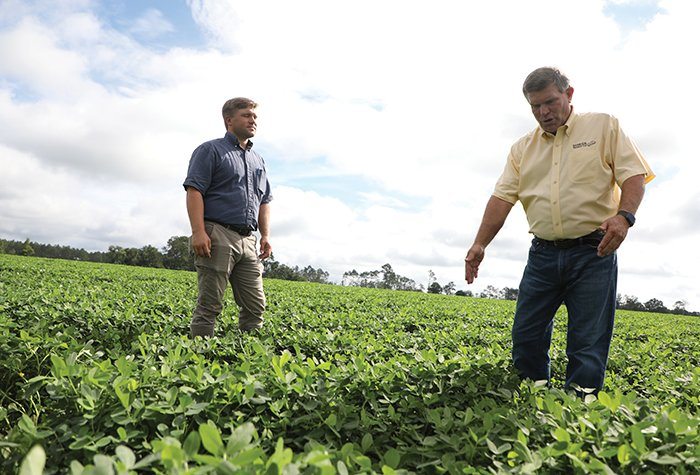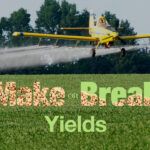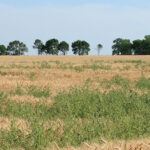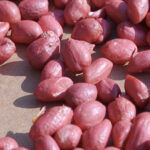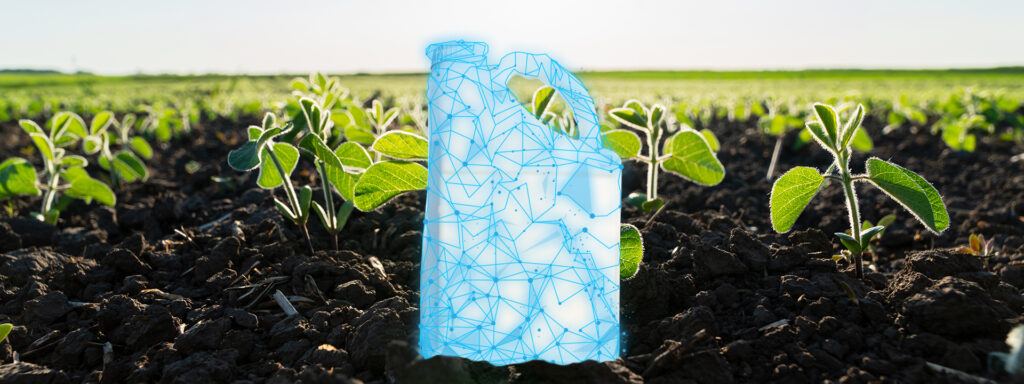Georgia Peanut Farmer Focuses on Disease Control to Improve Crop Yield
Controlling disease at Southern Grace Farms also helps farmer Tim McMillian reduce the quality and yield impact from weather conditions.

Tim McMillian, a seventh-generation farmer who operates Southern Grace Farms in southern Georgia, sees two challenges on his farm: one he can’t control and one he can.
“We’ve been blessed to yield well on our farm, and in my experience two things have the biggest impact when it comes to yield,” McMillian says. “The first being water, whether you get too much or too little. The second limiting factor is disease.”
The McMillian family grows cotton, fruit and peanuts. They also own Berrien Peanut Co., which prepares 15,000-20,000 tons of peanuts for shelling each season. Each peanut season, McMillian treats for white mold and early and late leaf spot. “I can remember when white mold was the primary disease that we felt like held us and our yields back,” he says.
White mold, a soilborne disease, still is a driving factor, says Wilson Faircloth, an agronomic service representative with Syngenta also known as the Peanut Doctor.
“The most susceptible parts of the plant are the stems that touch the soil,” Faircloth says. “If fungi colonize a peanut plant, they can destroy plant tissue and kill that part of the plant. Soilborne diseases can take your entire yield if they go unchecked, because they can eventually kill the entire plant.”
In addition to white mold, peanut farmers in the lower Southeast now tackle increasing pressure from a myriad of peanut disease, including early and late leaf spot.
Leaf spot diseases don’t necessarily kill the plant, but can cause defoliation severe enough to impair the plant’s ability to produce peanuts. “Every leaf is a machine, right? It’s a source of energy that sends nutrients down to the developing peanuts,” Faircloth says. “So if you start losing a lot of leaves early in the season, then you just simply don’t have enough to feed the developing peanut.”
One of the biggest challenges with late leaf spot, for example, is damage dictating digging decisions. When leaves begin to fall off toward the end of the season and growers must harvest prematurely, it affects marketable yield potential.
Left untreated, these diseases can cause 75% yield loss or more, depending on the level of pressure in a field, Faircloth says.
While it can be scary taking that leap, I didn’t mind switching. You’re used to putting on an application every two weeks and now you’re saying I can wait up to four weeks? That’s not a small thing. Farming is gambling anyway, but if I’m going to go big with it, I want the data to back me up.
“For white mold, chemistries were introduced that helped boost our yield against that disease,” McMillian says. “And today, although I worry about leaf spot and white mold, they’re less of a yield-robbing issue in our peanut fields because we have strong chemistries to control it.”
Weighing the Options
The question, Wilson and McMillan note, isn’t whether growers should implement a peanut disease control program, but how aggressive they need to be. Faircloth explains that effective control is achieved before disease appears — think preventive over reactive. A quality disease management program can cost between $85-$150 per acre, depending on products and application rates.
The question for a grower, however, is whether the resulting income justifies the investment.
“We spend about $50 more per acre on fungicides than some farmers do, but we’re making $250-$300 more per acre by spending that additional $50,” McMillian says. “Some farmers try to save that $50 and get by as cheaply as they can, but they’re yielding 1,000 to 1,500 pounds less per acre, which I believe has to do with disease control.”
Faircloth encourages growers to consider three factors when planning their fungicide program:
- Select varieties with higher tolerance of specific diseases
- Rotate crops to cut down on inoculum potential
- Incorporate as many different Fungicide Resistance Action Committee (FRAC) groups as possible
Risk? Or Reward
Low-cost fungicides can be helpful at certain times during the growing season, Faircloth says. However, he sees yield results that show the most effective fungicide programs are built around the newest products and include good resistance management.
Through his research at Virginia Tech, extension pathologist David Langston, sees the economic advantages of using a mix of older and newer chemistries. “It’s good to have something like Bravo® that you can rotate and try to preserve these newer, premium chemistries,” Langston says. “But some fungicides are uniquely suited for providing a good return on investment.”
He’s seen those results in multi-product trials that include Miravis® fungicide. “It has shown not just great efficacy on leaf spot, but also excellent residual activity,” he says.
Where some other fungicides need reapplication within a 14-day interval, Langston’s trials show Miravis offers residual activity that extends out 21 to 28 days. Additionally, Langston says, growers who pair Miravis with Elatus® fungicide increase overall disease control.
“You’re picking up great leaf spot control,” he says. “Your white mold control is equivalent to the industry standard, plus it has better residual control, and it manages southern stem rot.”
In a 2020 trial1 across three locations, Langston found that each of the tested fungicide programs controlled late leaf spot, noting that a Miravis/Elatus combination rotated with Bravo/tebuconazole provided the most significant improvements to late leaf spot control, in addition to showing higher yield, compared to other fungicide programs.
Doing More with Less
McMillian grew up watching his father take risks and incorporate progressive farming techniques. This innovative background, and the fact that Miravis was backed by university research, was why McMillian tried the fungicide.
However, telling farmers who have grown peanuts for years they can skip sprays, or extend the application window, goes against patterns that have been ingrained for generations.
“While it can be scary taking that leap, I didn’t mind switching,” McMillian says. “You’re used to putting on an application every two weeks and now you’re saying I can wait up to four weeks? That’s not a small thing. Farming is gambling anyway, but if I’m going to go big with it, I want the data to back me up.”
Many peanut farmers also grow cotton and other crops and may raise cattle, and they want to take advantage of every minute. The expanded residual activity and extended application window gives growers management flexibility they need.
“They’re trying to harvest corn; they need to spray peanuts and cotton,” Faircloth says. “If they can delay the spray on peanuts, they can spend more time on other tasks.” Residual activity also offers peace of mind when a spray is delayed as the result of bad weather, as is common in most peanut seasons in the Southeast.
Langston stresses that any spray program depends on the situation. His advice to growers? Keep it simple: Follow proven advice and don’t try to get cute and cut corners when it comes to using fungicides.
You can’t manage peanut diseases with blinders on,” he says.
Peanut Rx: Getting the Conversation Started
University researchers developed Peanut Rx, a disease risk index, for growers at a time when tomato spotted wilt virus was ravaging peanut fields, then expanded it to include other diseases. The index helps growers understand disease risk in their fields so they can make customized decisions on their fungicide program.
Plant pathologists from University of Georgia, University of Florida, Auburn University, Mississippi State University and Clemson University annually review disease pressure indices based on different factors, such as:
- variety selection
- planting date
- tillage
- plant population
- field history
- irrigation
- crop rotation
Peanut Rx gives farmers a path to follow to manage their risk and make performance-based decisions.
Brock Ward, a former University of Georgia extension agent who is now an agronomic service representative for Syngenta, says, “Most peanut producers now realize they’re under heavy pressure and need to plan their season with that in mind. The key is if you start clean, it’s easier to stay clean.”
Visit PeanutRX.com to assess your risk and start planning for 2023.
- Georgia farmer Tim McMillian uses a peanut disease program that drives higher yield and profit potential.
- Disease control starts before symptoms show up.
- Robust disease control pays off with increased yield.











